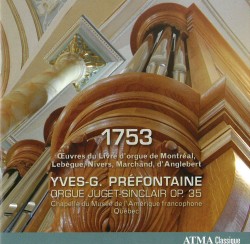 1753 – Livre de Montréal
1753 – Livre de Montréal
Yves-G. Préfontaine
ATMA ACD2 2717
Review
The brand-new organ in this recording is a replica of an instrument (no longer extant) built in 1753 in Paris for the Cathedral in Quebec City. It contains ten stops, all but two of which are divided, offering different timbres to the upper and lower halves of the keyboard.The repertoire features works likely known to 18th-century Quebec players, including a six-movement Magnificat from the so-called Montreal Organ Book, the manuscript transported to New France in 1724 and discovered in the 1980s. The composers of the nearly 400 pieces in this collection are not named, but a couple of dozen are definitively attributed to Nicolas Lebègue. Appropriately, a further group by Lebègue (not from the MOB) follows, alongside representative compositions from his period by Guillaume-Gabriel Nivers, Louis Marchand and Jean Henry D’Anglebert.
There are 34 tracks; each piece lasts on average just over two minutes. Generally in classical French keyboard music one anticipates descriptive titles but there is only one, Lebègue’s “Les Cloches,” with its descending four-note scale suggesting bells. The rest are either liturgical pieces or fugues and other abstract types. The divided stops show to advantage in several pieces with prominent bass solos or based on dialogue between registers. Préfontaine demonstrates remarkable variety of approach and a good deal of freedom within the French baroque style, recalling the comment of a great figure in this music, François Couperin: “We write differently from what we play.” The performances are intelligently lifted off the page. The disc is well produced and a pleasure to hear. Listeners curious about how the Chapelle instrument looks as well as how it sounds may be disappointed however: front and back cover photos show portions of it, but the only artist photo shows Préfontaine at a much larger console, unidentified.



